How to use AI for Marketing

With all the popularity of ChatGPT and GPT4, you might be wondering if you can use ChatGPT for marketing. Well, you can.
ChatGPT can assist in creating marketing copy, including emails, blog posts, product descriptions, ad copy, headlines, website copy, and social media captions. It can also generate newsletters, scripts for video ads and aid in project premortems.
Let’s take a look at how professional marketers and ad strategists are using ChatGPT to make them more efficient at their jobs.
Creating a newsletter with ChatGPT
With a single (massive) prompt, you can generate the entire outline of a newsletter using ChatGPT.
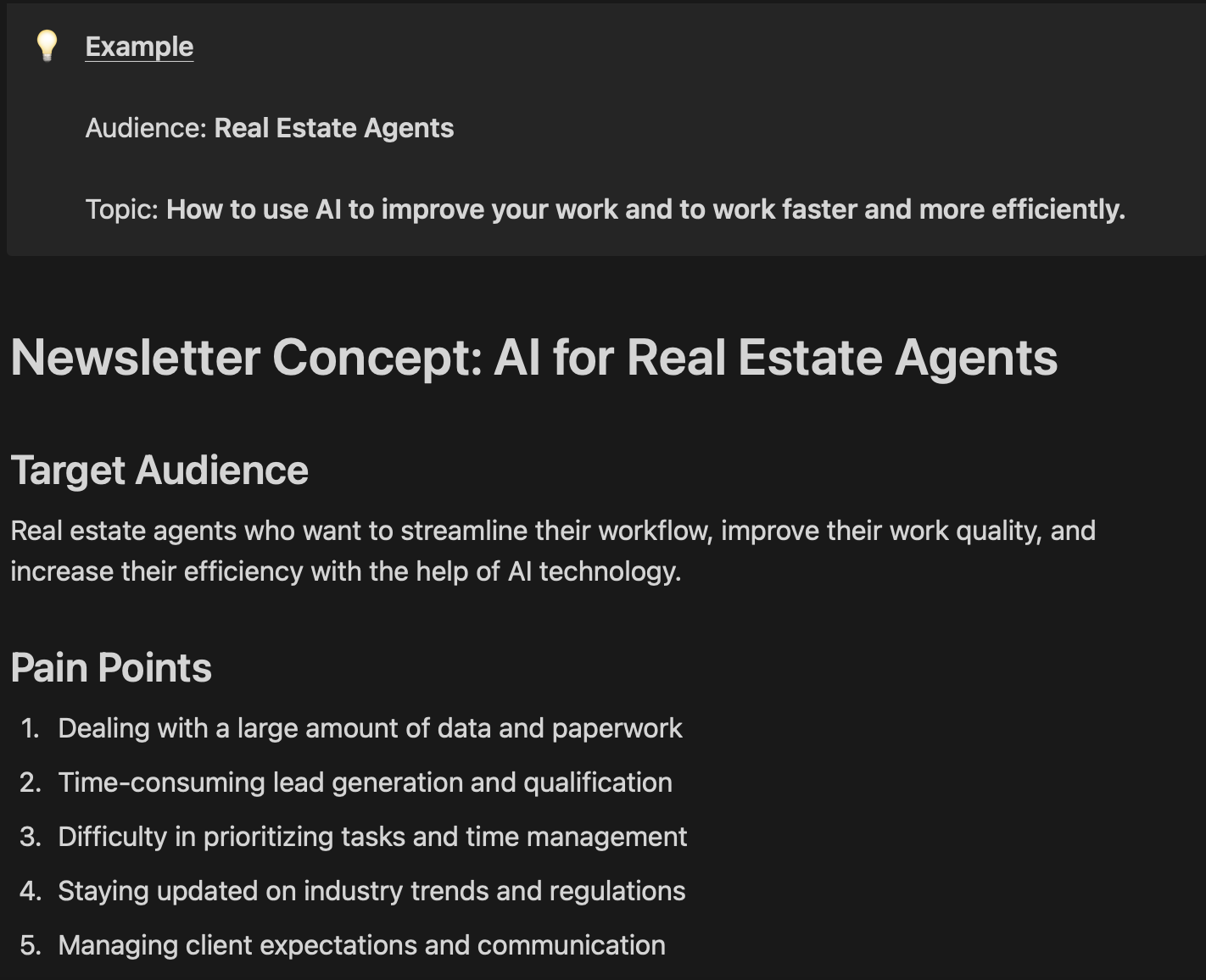
Prompt: You are a professional newsletter growth expert. I want you to help me create a newsletter concept. It should work as a project description, where the entire concept is outlined.
IMPORTANT: Format everything using Markdown
---
Audience: [Enter Your Nice Target Audience]
Topic: [Enter Your Defined Topic]
The concept should include:
Who is the target audience? - The target audience.
What are their main pain points? - List 5-10 of the [audience] main pain points, questions, and problems related to [topic].
Suggested newsletter names - Come up with 10 name suggestions for this newsletter concept (“[Topic] for [Audience]”). Rather than suggesting obvious names, play with words, write conceptual names, and make them short and snappy.
Potential Sub-topics - 10 sub-topics with examples. They should make sense together with the main topic. Add a few examples for each sub-topic.
Potential competing newsletters - What other newsletters already exist about [Topic] for [Audience] or similar? List up to 5 in this format: Name | a short description of the newsletter and its content | Link to the opt-in page.
How is this newsletter unique? - How the newsletter is unique from other newsletters about AI, and from different AI tools already creating content. IMPORTANT: Make comparisons with the newsletters you listed above and describe how this newsletter can be unique and different compared to them. Include a list of 3-5 concrete examples of how it is unique.
How will the newsletter HELP? - How the newsletter will the target audience (How does it help your audience do something that matters to them? Reach a goal, remove a pain point, etc?)
How will the newsletter INSPIRE? - How will it INSPIRE them to action?
How will the newsletter EMPHASIZE? - How will it show them that we see the world from their eyes, understand their situation, and EMPHASIZE with them?
Content Format - An outline for the format of the newsletter (incl. different content blocks and sections). Include a description of the type of content in each section (essay, curated links, links with our own take on it, etc)
Sponsor Pitch - Write a 2-4 sentence description of the newsletter to describe it for sponsors, advertisers, and other collaborators. The goal is for them to understand why they would get value from working with this newsletter. It should include who the readers are, what the newsletter will help them achieve, and what the content of the newsletter is. Also, include how it is unique compared to all other newsletters in the same niche/topic.
Potenital Growth Tactics - Suggest 5 free and 5 paid ways for how to grow the newsletter.
The credit for this prompt goes to Jens Lennartsson, who runs a newsletter marketing company called The Marketing Mule.
To use this huge prompt for your business, you need to know the topic of your prompt and your target audience. After that, you insert this information in your prompt, and here’s what it generates for you:
A nice description of the target audience
Pain points for your target audience
Some suggestions for the name of your newsletter
Subtopics that would be relevant to your newsletter
A list of competitor newsletters (Pro tip: this doesn’t work)
A description of how your newsletter is unique compared to the competitors
A description of how your newsletter can help solve your audience’s problems
An outline for the actual content of the newsletter (Pro tip: this is really helpful)
A pitch that will help you explain how your newsletter is adding value for the readers
And strategies for the growth of your newsletter
You can likely come up with all of the points listed above, but you will probably spend at least a couple of hours figuring them out and noting them down. However, with Jens’ prompt, AI can do the initial “thinking” for you.
Now, of course, this outline isn’t perfect. You will find several errors or even downright AI-hallucinated content. But that doesn’t mean that you aren’t saving time. Within a few minutes, you will get a workable outline. You can further build upon it to improve it even more.
Hence, AI can help you save all that extra time that would have gone towards research or brainstorming. This is especially helpful for small businesses that want to start a newsletter.
Initially, a newsletter can be a very demanding task, especially for small businesses where the owners are putting out fires on many different fronts. You need to research things, write about them, make them pretty with pictures, and then send them out. And you need to keep doing this every week - or whatever the frequency of your newsletter is.
Since you have to do it so often, you are likely to run into a creative block. That’s where ChatGPT can be especially helpful if you use this prompt. It can give you some ideas that you can further improve.
But you can’t rely on this prompt alone. It would require your input. And that’s one of its limitations. Let’s talk a little more about that.
Limitations and possible improvements
Firstly this prompt doesn’t generate a newsletter itself - it creates an outline. It will help you think about what to write in the actual newsletter. However, I found a way to make it write the newsletter too.
All you have to do is paste the content structure that ChatGPT generates in another prompt and ask it to write the newsletter based on the outline it created. And it will generate a newsletter for you.
Prompt: Based on the outline you have generated, please write the newsletter using the following content structure: [paste content structure]
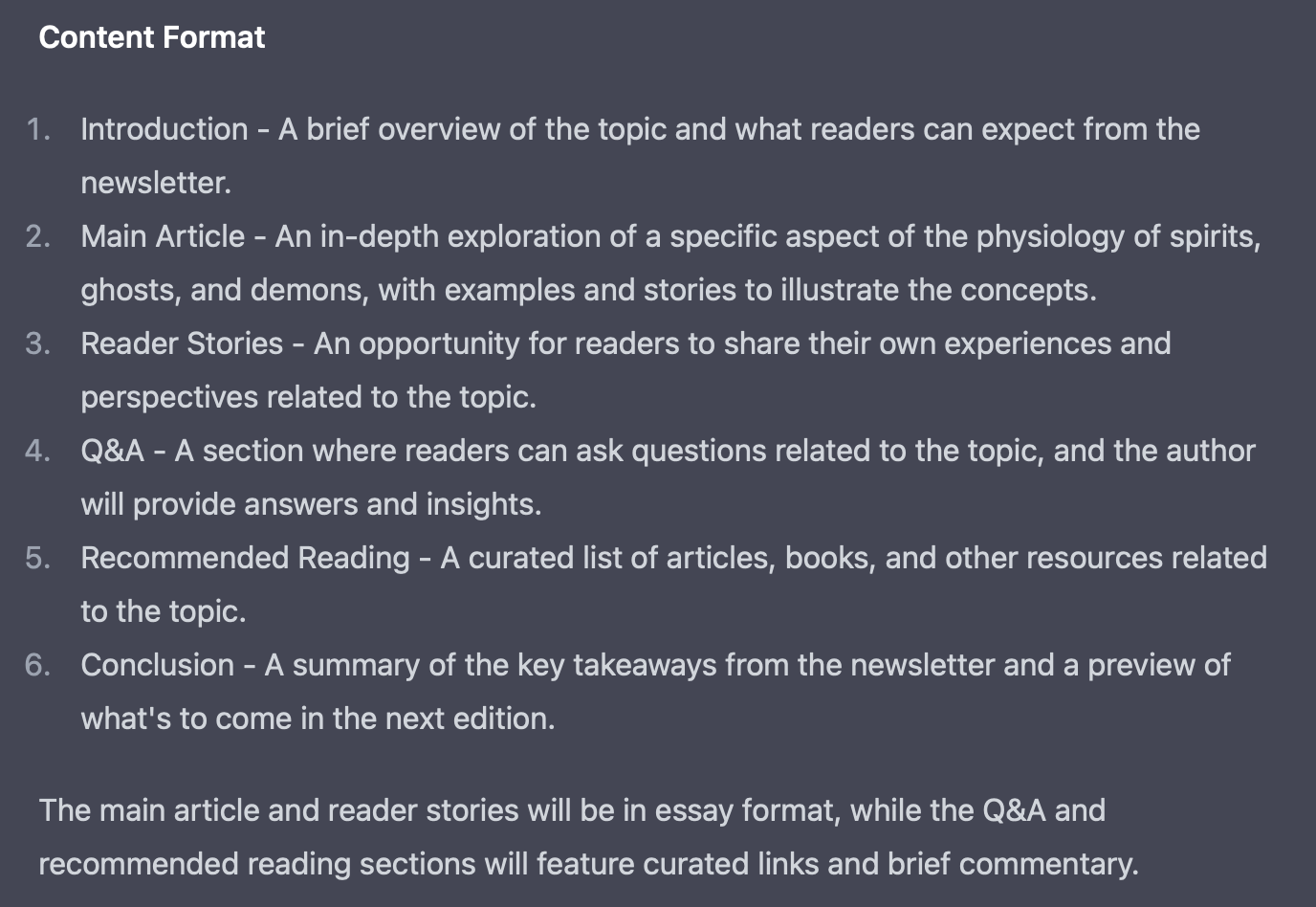
Since it’s a big output, ChatGPT often fails to produce it all in one go. It might cut off in the middle of the text, or it might give you an error like the following:
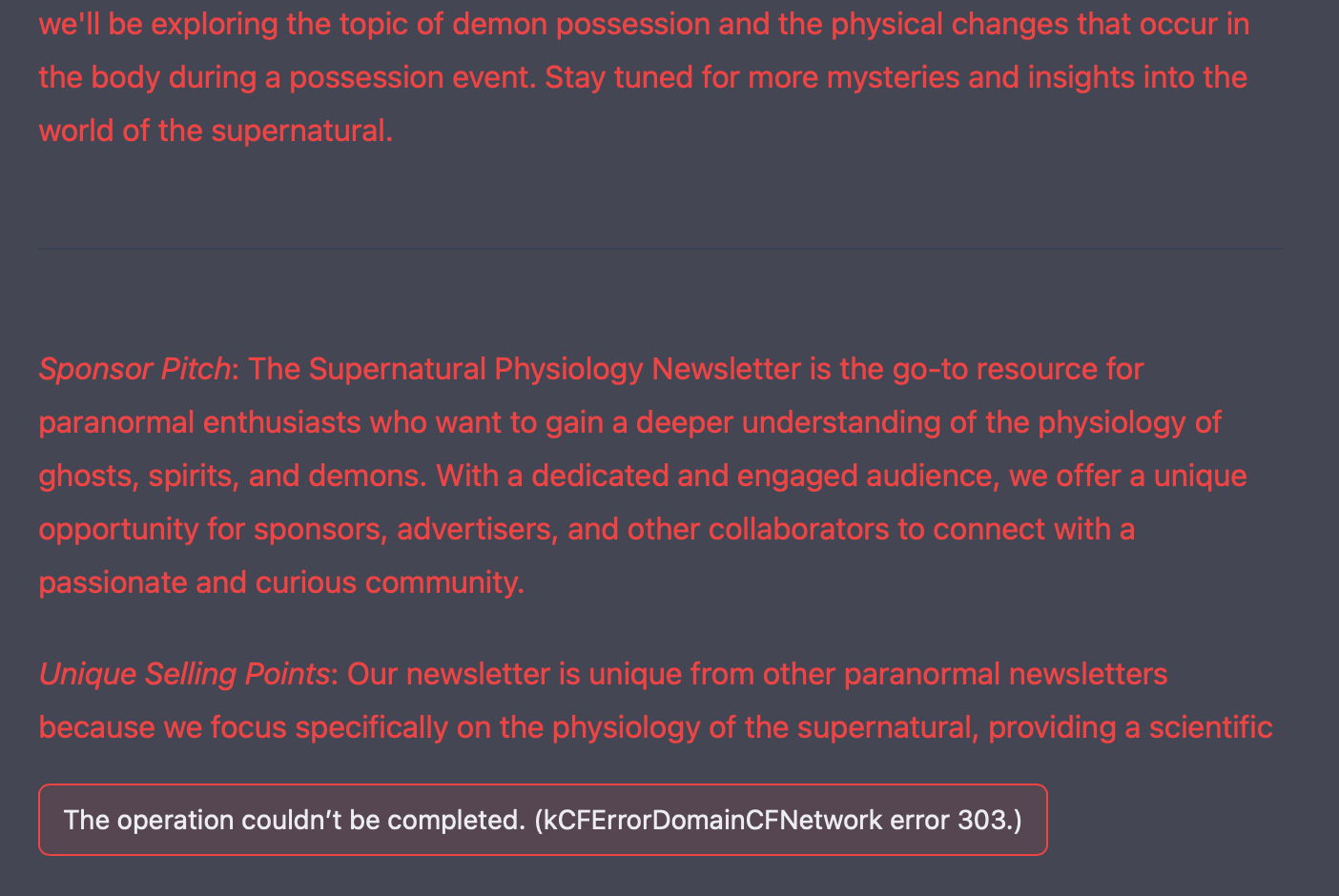
The easiest fix is just asking it to continue generating the text again from where it left off with the following prompt (or you can use something similar to this prompt):
Prompt: Continue exactly where you left off
And, of course, there’s the problem with AI hallucination. ChatGPT often gives you a list of competitors that don’t exist, with URLs that don’t work. Furthermore, it tends to incorporate information that doesn’t really make sense. Therefore, you need to ensure that you carefully go through the text and fix any errors. This is a constant problem with AI tools, but I guess we can’t really expect them to be perfect. They are tools, after all, and human input can’t be substituted.
If you want to read more about Jens’ work and the prompt, you can check out his Twitter thread.
Creating Facebook (Meta) ads using ChatGPT
With a few prompts, you can now create an entire ad for social media websites. The mastermind behind these prompts is Mo Junayed. He is the co-founder and the head of creative strategy at Groth Digital, a marketing firm that helps e-commerce businesses in expanding their profits through creative ads.
Prompt 1: what are some of the problems [product you are trying to sell] solve
Prompt 2: Elaborate on problem [relevant number from the list of problems]
Prompt 3: What would be an ideal customer avatar that would purchase the [product] to solve the above problem
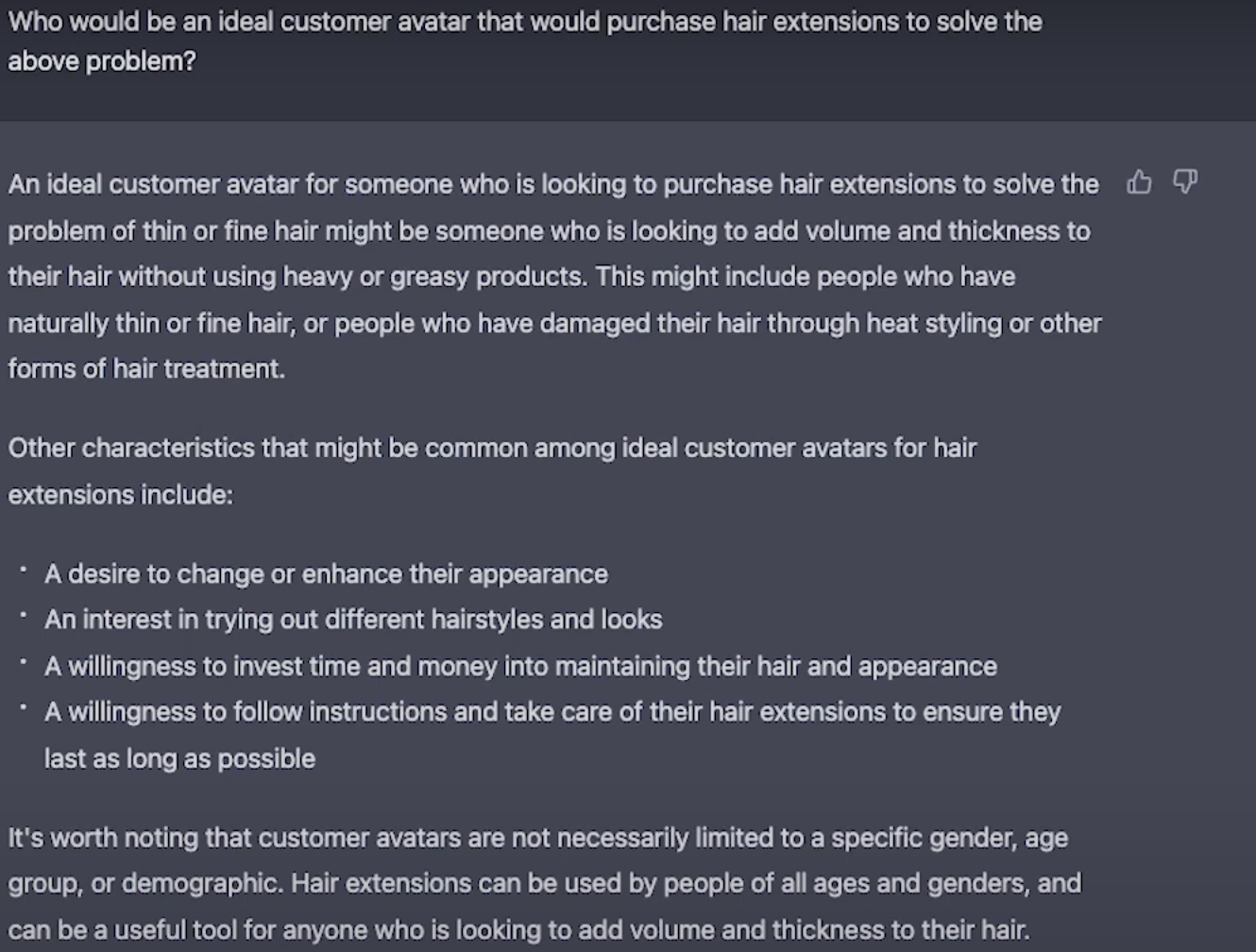
Prompt 4: Create an ideal customer avatar based on the information above
Prompt 5: Consider yourself an advanced marketer who has been advertising for decades, recreate the ideal customer avatar considering the information that we are trying to sell to [insert target audience]
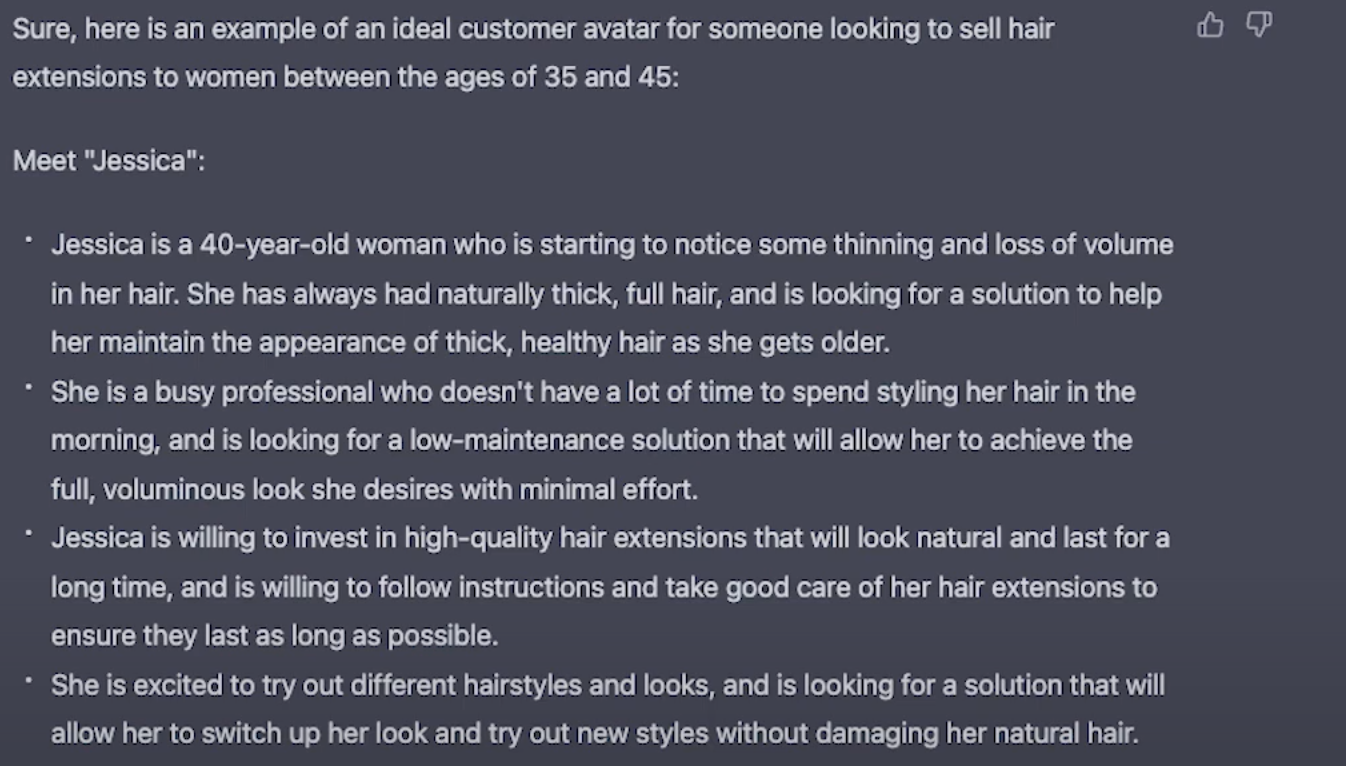
Prompt 6: Write a sales letter to [avatar] using principles from breakthrough advertising and principles from David Ogilvy on copywriting
Prompt 7: Turn this sales letter into an ad script that would work on TikTok and uses millennial language
Prompt 8: Rewrite the ad script using the problem, agitate, solution framework, a script that is enough for a 45-second video and make it more persuasive
Prompt 9: Rewrite the ad script using the problem agitate solution framework, keep in mind that the person is frustrated and has used multiple products and [alternative solutions] and has found [product you are trying to sell] to be the best solution because the results are instant
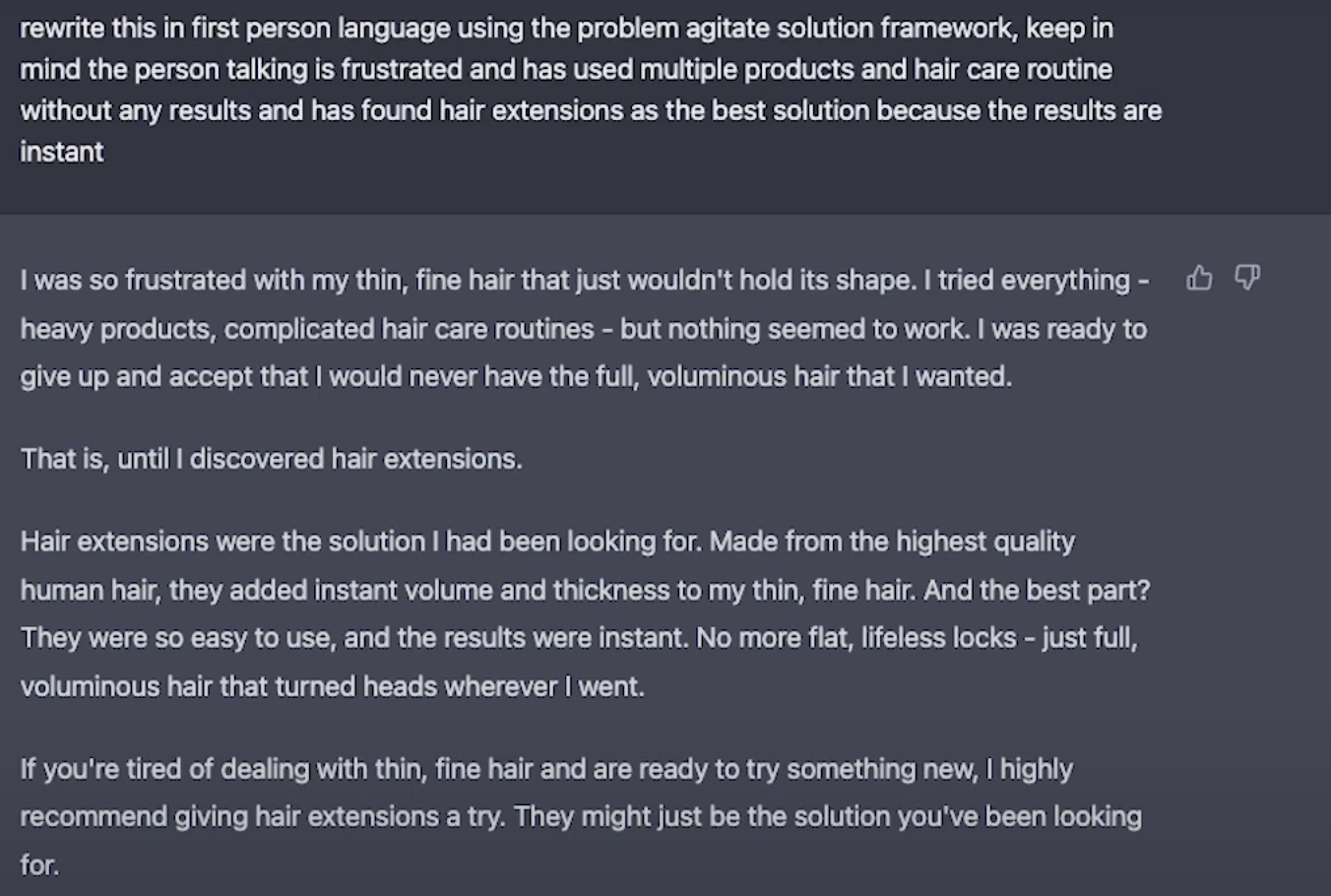
And there you have it; 5 minutes and 9 prompts later, you have a complete script for an ad that you can use to create a 45-second video advertisement for different social media platforms.
The best thing about this prompt is that it actually works. Mo decided to create an ad using this script, and he ran it on Facebook.
For this particular ad, he ran four different variations and found that the click-through rate (CTR) was 1.51%. Mo claims that the CTR is slightly above average, which shows that the ad is effective.
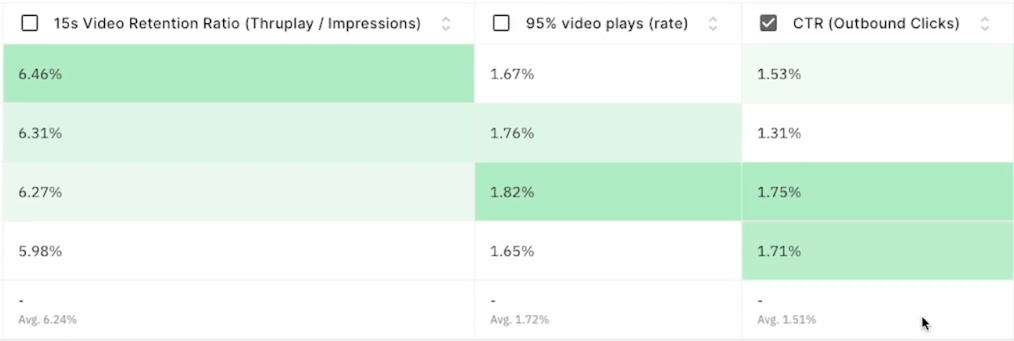
Mo says that this is one of the easiest ads he has ever created. Usually, he would spend hours researching all these things himself. He would have to come up with the pain points of the customers, think about the customer avatar, and then write a script.
But now, he got it all done within 5 minutes. And I imagine that’s the case for most creative strategists. They can probably do all that ChatGPT is doing, but it will take them a little while. And here, ChatGPT can take all that extra thinking workload off their hands.
Like the newsletter, it helps in saving time. However, it can’t be relied on. Just by looking at the prompts, you can see that ChatGPT needs several human tweaks. And you will obviously need to optimize the script to align it with your brand’s tone.
Again, AI can’t replace human expertise. So if you are a small business and you think you can rely on AI alone to sustainably generate great ads for you, it probably wouldn’t work. It can’t replace an advertising strategist for a business. But it will help in making that ad strategist’s life considerably easier.
Here’s the video where Mo documents his entire workflow:
Using ChatGPT to write website copies, Instagram bios, and more
If you want some help understanding the pain points of your customers or you want to write website copies quickly, you can now do that with ChatGPT. Thanks to Zoe.
Zoe Marcar is a social media manager who runs a marketing agency called ZJM Marketing which specializes in beauty and wellness businesses. She recently came up with some pretty interesting ways to use ChatGPT for marketing.
Understanding your customers’ pain points
Prompt: I own an [whatever your business is] what are some of the pain points for my target audience?

ChatGPT gives you a list of some of the pain points of your customers. Now, you might be able to figure out all of these on your own, but it will likely take you some time. However, with this prompt, you can get these in a few seconds.
Plus, I found another improvement on this prompt. You can use another prompt to ask ChatGPT to generate further results:
Prompt: Great, now give me some suggestions.
This helps in generating some new ideas. In fact, sometimes, those ideas may be completely novel, even for you. So, it’s a great tool for brainstorming about what your customers might be struggling with and how you can help them.
Of course, this wouldn’t cover all of the pain points of your target audience. However, a skilled marketer can easily use these points as a base to expand further upon them.
Here’s a link to the post where Zoe explains how to use this prompt.
Writing website copy with ChatGPT
Prompt for the “About Me” page: write an about me page for my website promoting my social media management services, details about me: my name is zoe, I am 22, I have worked in the marketing industry for 5 years, I have a first class honors degree from liverpool john moores university, I worked at a marketing agency for a year after uni, I am into tarot cards, I love running, moon cycles and manifestation, and a self help book
Prompt for writing a “Thank You” page: write a thank you form submission page, saying thank you for getting in touch with us and someone will be in touch soon
These prompts will help you in generating written content for your webpage. Zoe also has some tips for writing these website copies:
The more information we add to the prompt, the better our results will look.
We can also tell ChatGPT to adjust the tone according to us e.g., informal, funny, millennial, etc.
If you run a small business or you are just starting a new business, you will likely need to write the first few pages yourself, and that’s where ChatGPT can help.
Again, this wouldn’t replace your website’s copywriter. However, it can make their job easier.
Here’s a link to the post where Zoe explains how to use this prompt.
Writing an Instagram bio
Prompt: turn this into an Instagram bio and cut it down to 150 characters: [insert a description of everything you want to add to your bio - this can be as long as you want]
Zoe says that a lot of people tell her that they struggle with writing an Instagram bio because they have to put everything into 150 characters. But with this prompt, you will get a 150-character bio that you can easily use for your Instagram account.
Of course, the bio may not be perfect, and you may need to tweak it. But it certainly makes your job a lot easier.
Moreover, you can also ask ChatGPT to give you 5-10 different versions of the bio to help you choose the best one that represents your needs.
Here’s a link to the post where Zoe explains how to use this prompt.
Doing a premortem with ChatGPT
ChatGPT can also help you identify ways your projects might fail. First, you need to paste the information of your project into ChatGPT and then ask ChatGPT to tell you how it will fail.
Prompt: [paste project information] give me three paragraphs each of which tell the story of how the product development effort failed. Focus on the potential failure to produce the prototype by the deadline, not long-term sale. Be very specific and detailed using the proposal I gave you.
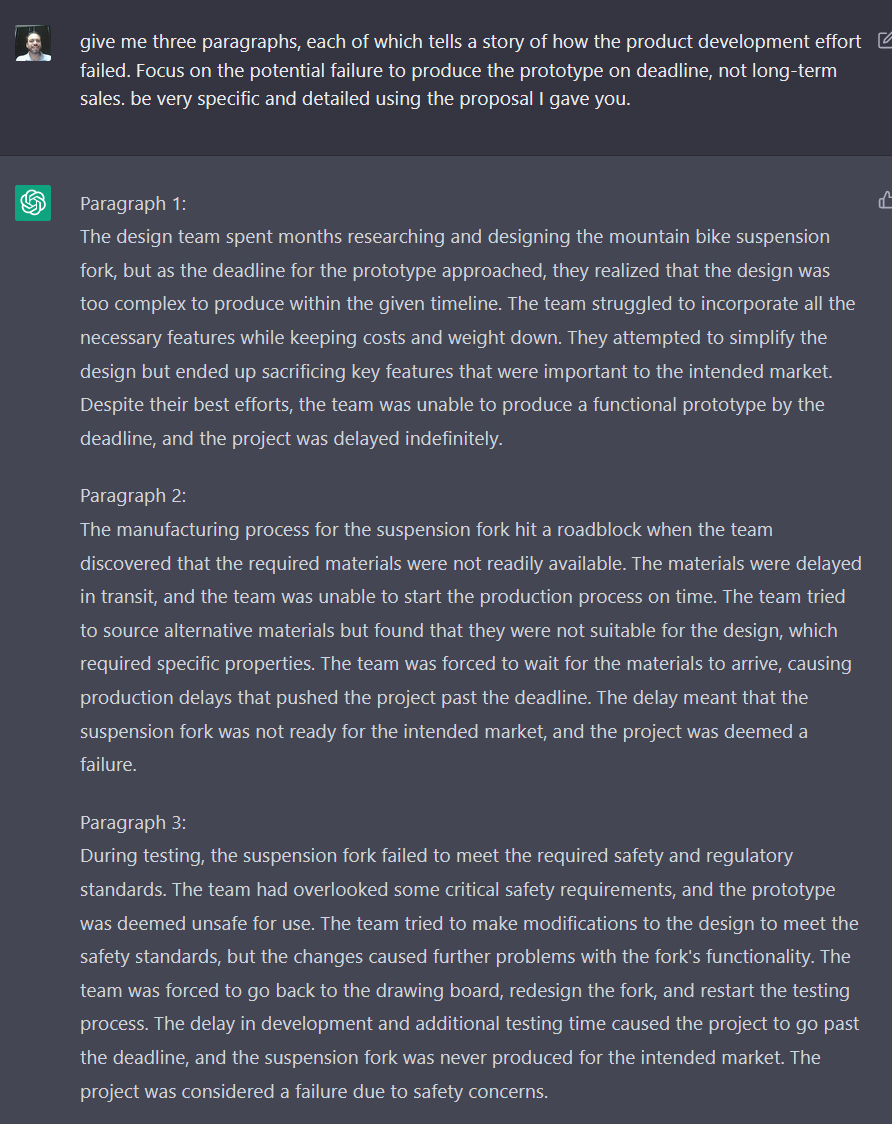
You can also ask ChatGPT to give you potential solutions to fix these problems, and it will give you some logical, actionable advice.
The person who figured this prompt out is Ethan Mollick, an associate professor at the Wharton School of the University of Pennsylvania.
Premortems are a strategy for increasing the chances of your project’s success. Essentially, it’s the project team all sitting down together and brainstorming reasons for how their project could fail.
Mollick claims that doing a premortem can increase your ability to identify different reasons for failure by up to 30%.
Like all the other examples in this article, this is another use case where a project management team can probably do all of this work on their own. But it might take them a couple of hours. And that’s where ChatGPT is helping - it’s saving their time.
With this prompt, you can get some starting points, and then you can expand on them based on your expertise. But please note that AI isn’t perfect. It might give you something that doesn’t really make sense. Therefore, you need to thoroughly understand the project and make sure that you evaluate the logic and the legitimacy of all the concerns presented by ChatGPT.
You can learn more about this prompt and premortems on Mollick’s original Twitter thread.
Conclusion
We have seen several different examples of how people are using ChatGPT to improve their efficiency in marketing. The main theme here is that ChatGPT is saving people’s time by helping them come up with some initial ideas. These initial ideas can then become the basis of more sophisticated marketing strategies.
One common element for these examples is using AI to identify the pain points of different customers. Experienced marketers can already do that, but it will likely take them at least a few minutes to come up with the pain points. However, with ChatGPT, they can get some pain points to start with within a few seconds using a single prompt.
Ultimately, you can’t rely on AI to replace human input just yet. It can’t sustainably generate content that adds value for the readers, and you will obviously need to tweak the text it generates to optimize it.
But if you are looking to save time, ChatGPT can definitely help with that. So the take-home message here would be to think of ChatGPT as another tool that you use to become more efficient at your job, not as an expert that can do your job for you.